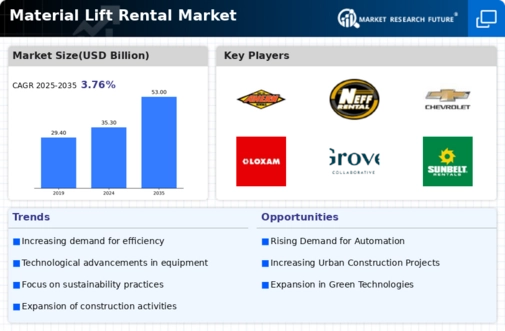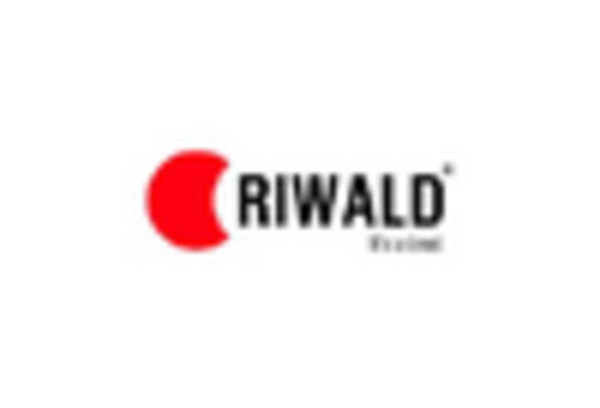Focus on Cost Efficiency
Cost efficiency remains a critical driver in the Material Lift Rental Market. Many businesses are opting for rental solutions to avoid the high upfront costs associated with purchasing equipment. In 2025, it is anticipated that the rental market will account for approximately 30% of the overall material handling equipment market, underscoring the shift towards rental models. This trend is particularly evident among small to medium-sized enterprises that may lack the capital for significant investments. By renting material lifts, these companies can allocate resources more effectively, focusing on core operations rather than equipment ownership. The Material Lift Rental Market is thus likely to see sustained growth as more businesses recognize the financial benefits of rental agreements, which provide access to high-quality equipment without the burden of ownership.
Sustainability Initiatives
Sustainability initiatives are becoming increasingly relevant in the Material Lift Rental Market. As environmental concerns gain prominence, companies are seeking eco-friendly lifting solutions that minimize their carbon footprint. The rental market is responding to this demand by offering equipment that utilizes energy-efficient technologies and sustainable materials. In 2025, it is estimated that the market for green rental equipment will grow by 25%, reflecting a shift towards environmentally responsible practices. This trend is particularly appealing to businesses aiming to enhance their corporate social responsibility profiles. By opting for rental solutions that prioritize sustainability, companies can not only reduce their environmental impact but also attract clients who value eco-friendly practices. Thus, the Material Lift Rental Market is likely to evolve in alignment with these sustainability trends, fostering a more responsible approach to equipment rental.
Technological Advancements
Technological innovations are playing a pivotal role in shaping the Material Lift Rental Market. The integration of advanced features such as telematics, remote monitoring, and automated controls enhances the efficiency and safety of material lifts. These advancements not only improve operational performance but also reduce maintenance costs, making rental options more attractive to businesses. In 2025, it is estimated that the adoption of smart technologies in the rental sector could increase by 20%, reflecting a growing trend towards digitization. As companies increasingly prioritize operational efficiency, the demand for technologically advanced rental equipment is likely to rise. This trend indicates that the Material Lift Rental Market will continue to evolve, driven by the need for innovative solutions that meet the changing demands of the construction and logistics sectors.
Rising Construction Activities
The Material Lift Rental Market is experiencing a notable surge due to the increasing number of construction projects worldwide. As urbanization accelerates, the demand for residential and commercial buildings rises, leading to a higher need for material lifts. In 2025, the construction sector is projected to grow at a compound annual growth rate of approximately 5.5%, which directly influences the rental market for material lifts. This growth is driven by both public and private investments in infrastructure, which necessitate efficient lifting solutions. Consequently, rental services are becoming more appealing to contractors who prefer flexibility and cost-effectiveness over purchasing equipment outright. The Material Lift Rental Market is thus positioned to benefit from this trend, as more companies seek to optimize their operations and reduce capital expenditures.
Increased Emphasis on Safety Standards
The Material Lift Rental Market is significantly influenced by the heightened emphasis on safety standards across various sectors. As regulatory bodies enforce stricter safety regulations, companies are compelled to invest in compliant equipment. This trend is particularly pronounced in construction and manufacturing, where the use of material lifts is essential for ensuring worker safety. In 2025, it is projected that the demand for safety-compliant rental equipment will increase by 15%, as businesses prioritize the well-being of their workforce. Rental companies that offer equipment meeting these safety standards are likely to gain a competitive edge in the market. Consequently, the Material Lift Rental Market is expected to thrive as organizations seek reliable and safe lifting solutions to adhere to regulatory requirements and enhance workplace safety.


















Leave a Comment